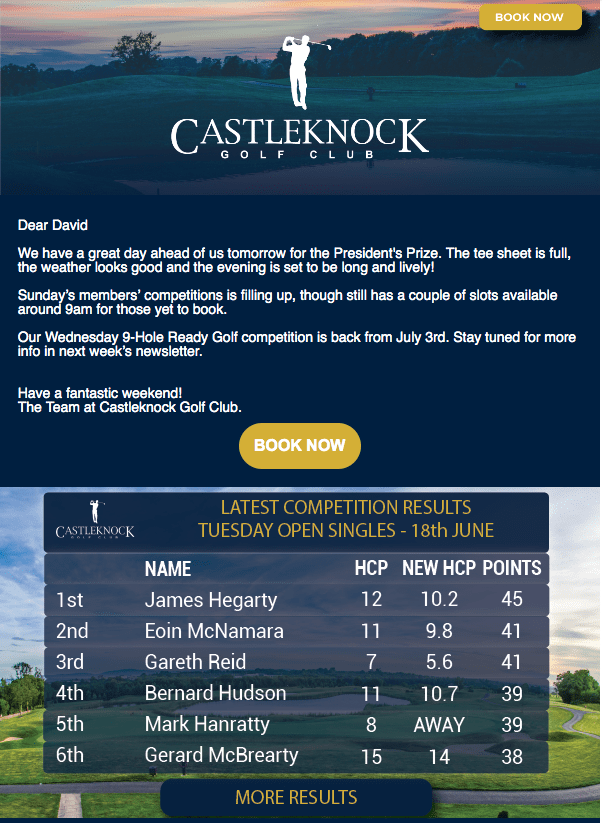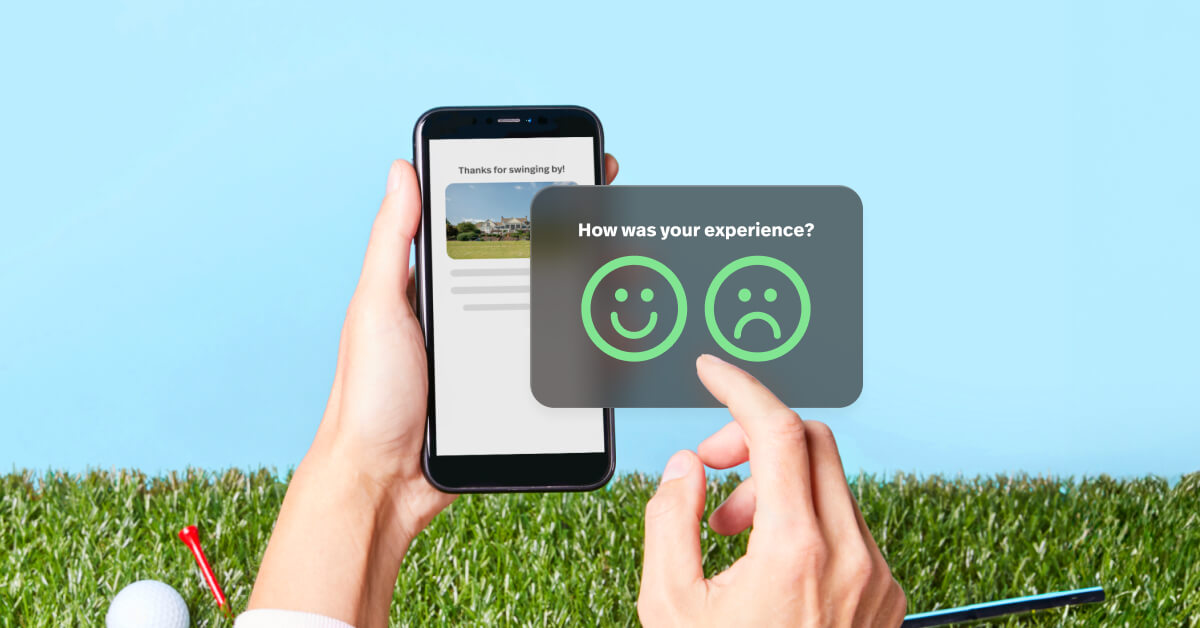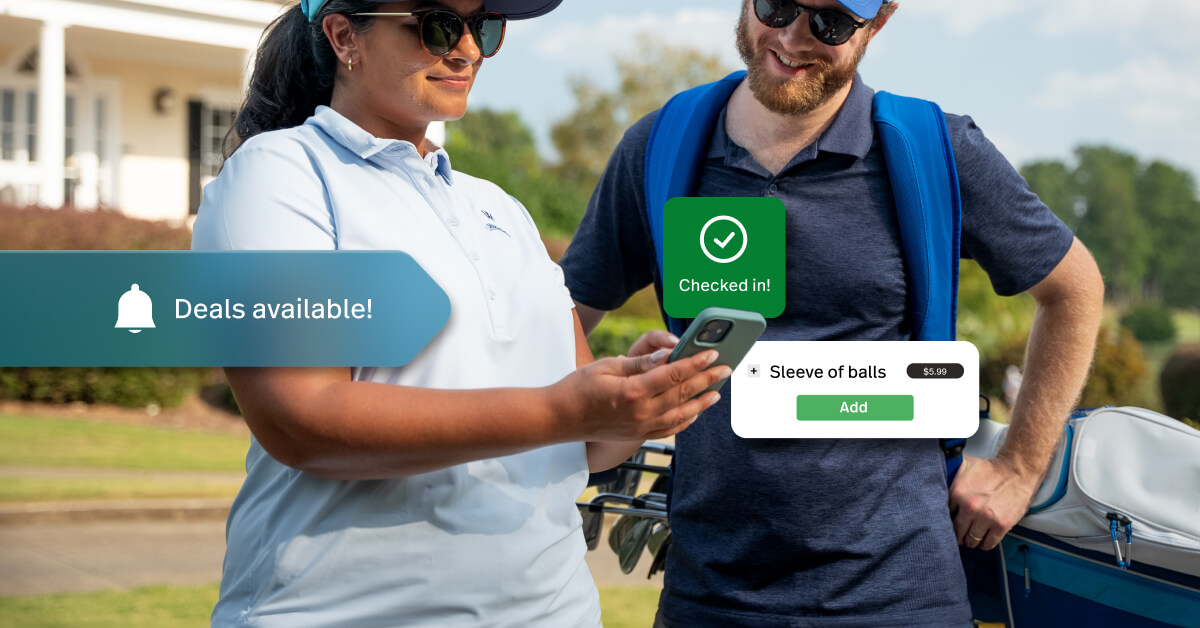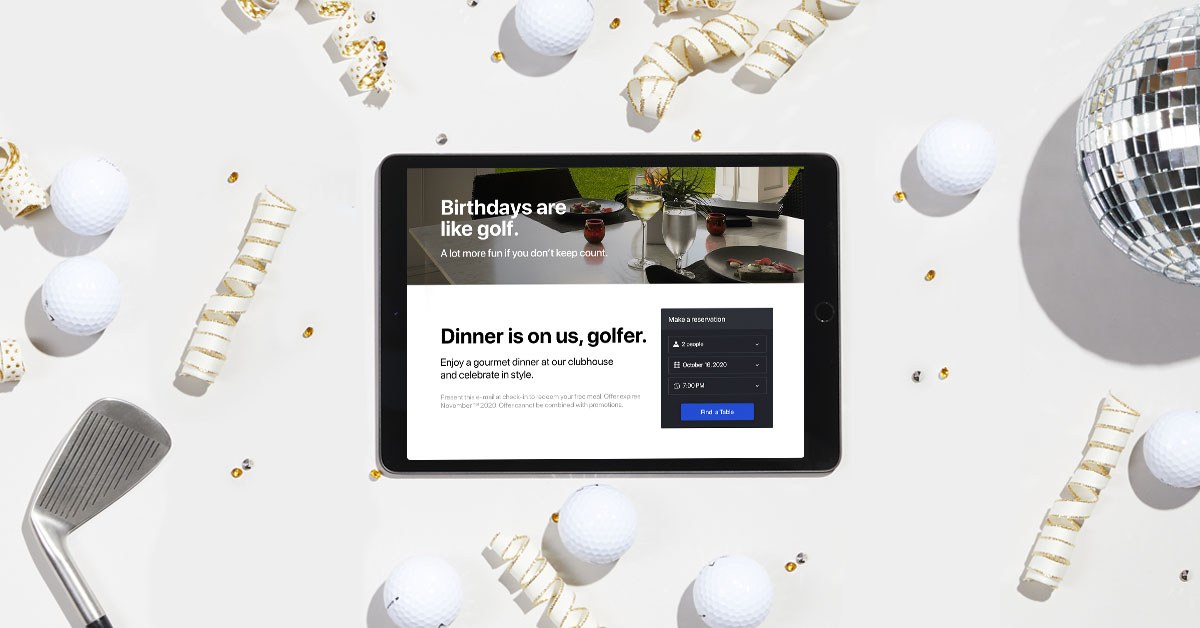
Your golf course newsletter is a critical component of your course’s digital marketing strategy, delivering news, announcements and deals straight to your customers’ inbox. More than that, they help you build your brand and create stronger relationships with your customers.
The numbers prove it: in a recent survey we conducted of 300 North American golfers, more than half of respondents (54.5%) aged 18-54 said they liked to receive weekly golf course emails to learn about upcoming events and promotions.
That said, there is a fine line between a value-add golf club newsletters and ones that are too spammy, plagued by poor design, too promotional and lack cohesive messaging.
Here are seven steps you can take to make your golf course newsletter ideas shine and better engage with your audience.
- Define your newsletter’s goal
- Balance content with promotion
- Create an eye-catching design
- Personalize subject lines
- Optimize for mobile
- Build lists
- Make it possible to opt-out
Ready to dial in your digital marketing?
Digital marketing is crucial to golf course success. Access the insights that prove it and discover tactics to reach more golfers.
1. Define the goal of your golf course newsletter
The first thing to remember when launching a newsletter is that each one you send out should have a goal. Defining the goal (or goals) of your newsletter will help inform other decisions, from messaging and layout, to audience segmentation and conversion strategies.
Some common goals for golf course newsletters are:
- Generate awareness about an event or tournament
- Update members with course-related news
- Sell more tee times
- Promote a deal in the pro shop or restaurant
- Celebrate player achievements and top customers
It’s possible to set multiple goals in a single newsletter, as long as you keep your messaging clear and focused. For instance, if you want to promote an upcoming tournament and offer a special discount at your club shop in a single sendout, just make sure each message is clearly distinguished and has an obvious CTA.
Ultimately, the goal of any newsletter is to generate traffic and clicks to your website or online booking page where, ideally, your audience can book tee times, purchase pro shop merchandise if you have an eCom store, game packs and more.
2. Balance content with promotion
One of the biggest mistakes golf courses make when sending their promotional emails is focusing too heavily on promotional material, instead of providing useful, interesting content that entertains, instructs or provides value.
While this may work in the short run, over time it may work against your business goals: if your audience feels like you are taking advantage of their inboxes strictly for advertising, they’ll slowly lose trust in your brand, and they won’t open or engage with your emails anymore.
That’s not to say that your emails should not include promotional content. According to the experts, the ideal ratio is 90% informative or educational, and 10% promotional.
It goes without saying that the informative part of your newsletter should be relevant to whatever you are promoting. For example, you can give relevant details about an upcoming tournament and also promote a deal on ticket packages for the tournament itself.
Remember: You can always send out dedicated promotional emails that are separate from your newsletter.
What content should I focus on in my golf club newsletter?
So, what type of content should make up that 90%? There are plenty of avenues golf clubs can go down here. The key is to get creative and invest in your content, as it can be a highly effective way to express your brand voice and provide value to your golfers:
- Instructional videos from your PGA professional
- Strategy videos
- Golf course flyovers
- Course history features
- Facility news and announcements
- Fun facts
- Updates from the world of professional golf
- Equipment reviews
3. Utilize a simple, effective, eye-catching design
Too many golf course newsletters fall short when it comes to design, deploying disparate colors, fonts and an inconsistent design language. The reality is that these newsletters communicate something about the value of your brand and will leave a less than positive impression with subscribers.
To generate engagement and keep your email audience content, you can follow these design guidelines:
Keep it simple and clean
Use a simple design layout, with blocks for each section of the newsletter and a single call-to-action (CTA) per block. Similarly, avoid using too many colors and don’t shy away from white space, since it helps guide readers to your CTA.
Stay consistent with fonts
Pick two or three typefaces and stick with them consistently across your sections. Ideally, the fonts you choose should reflect your existing branding. We also recommend using web-safe fonts, such as Helvetica, which will load across all devices and email servers.
Use your marketing assets
Your golf club should have a host of digital assets like logos and photos of your course and amenities. Use them! Integrating 1-2 images of your golf course per newsletter is valuable, both from a design perspective and in building your brand.
Keep content concise
Keep your wording clear, impactful and to the point. Ideally, you want to grab your reader’s attention in the first few seconds, and then get them to click through to your website, where they can access longer-form content and more detailed information.
Take your golf facility further
Simplify, scale and deliver exceptional customer experiences from course to the clubhouse with Lightspeed's powerful golf course management software.
4. Carefully consider your golf newsletter subject lines
To get people to visit your website and potentially convert, you need to employ catchy, relevant subject lines that inspire the receiver to open your emails on a regular basis.
One of the most effective ways to get clicks from your newsletter subscribers is to add a touch of personalization to your subject lines. Simply adding someone’s name to the email subject can up open rates by 26%. Fortunately, thanks to automation, it’s easier than ever to customize subject lines and newsletter content.
There are many ways to personalize your newsletter subject heading and we encourage you to get creative, but here are a couple of examples:
Hey [Name], take this 10% offer on twilight tee times!
[Name], time is running out to register for [upcoming tournament]!
There are also other strategies you can apply to your subject lines, like using descriptive messaging, limiting the use of emojis, and sticking to sentence case. You can read more of our subject line suggestions and other golf course newsletter ideas in this blog.
5. Optimize your newsletter emails for mobile devices
It’s absolutely vital to think about mobile audiences when sending out a newsletter. In fact, reports have found that 41% of emails are accessed via mobile devices, while 39% are viewed from a desktop computer (the remaining are viewed via tablets and other devices). All that to say: make sure your newsletters are mobile friendly.
There are a few things you can do to optimize your golf course newsletter ideas for mobile devices:
- Go with a single-column layout to keep the design streamlined and easy-to-read both on a full desktop screen and more compact mobile screens.
- Keep copy brief and well spaced to ensure you don’t end up with large blocks of text.
- Consider the use of images when optimizing a newsletter for mobile. Since big image files can take a long time to download and use up precious data, it’s best to use 1-2 eye-catching images or graphics.
- Ensure that your CTA stands out from the rest of the newsletter content. Your reader should be able to locate the CTA button within seconds of the email loading.
6. Build solid newsletter distribution lists
Just as important as putting together a collection of solid golf course newsletter ideas is having an audience to share them with. Building your email list should remain a priority for your business, and fortunately collecting valuable data is becoming easier than ever. Golf courses have many possible avenues for growing their email lists, since customers input their digital contact details when they:
- Book tee times online
- Make an ecommerce purchase
- Enter a social media contest
- Participate in a customer satisfaction survey
- Golf course employees can also ask for email contacts in person at the point of sale
A key part of this email capture is consent. Be sure to check up on specific regional laws surrounding online data capture consent, but generally speaking when a customer is willingly giving your business their email and contact details, simply give them an option to opt in or out of receiving newsletters.
With a growing email list, you can also take advantage of audience segmentation. In short, this means dividing your subscriber list based on interest, engagement or demographics to send out specific newsletter campaigns. Lightspeed’s Golf Course Reporting & Analytics can help your golf club’s marketing team to collect and make use of invaluable customer data.
7. Offer an easy way to opt out
For any promotional email you send, you are required to include an opt-out button. In many cases this is a requirement put in place by the law. Typically opt-out or unsubscribe buttons are found at the bottom of your marketing emails. Once clicked, they take the receiver to a page where they confirm their desire to opt out from select or all communications
Don’t worry. Most people won’t opt out unless you start spamming your lists with junky promotions or irrelevant content.
The key responsibility from your side is to ensure that the unsubscribe button is accessible and that your audience can opt out easily if they wish to. Remember, you can always ask them to provide feedback on why they are opting out, which can inform your understanding of customer satisfaction.
What do these golf course newsletter ideas look like in practice?
Here’s an example of a golf course newsletter that we really like.

In this A+ newsletter from Castleknock Golf Club, there are a few interesting things happening.
- First, there’s lots of information about the course’s upcoming events and a clear call-to-action inviting the addressee to book a round.
- You’ll also notice the consistent branding with easy-to-read fonts and copy.
- What really stands out, though, are the tournament competition results, presented like a scoreboard with lots of noteworthy stats.
- That “More Results” button underneath the tournament scores begs for a click, and members who play well and rank high in the standings get that extra reward for their participation in the tournament.
- Promoting tournament leaderboards is an excellent way to encourage clicks to your website and generate incremental tournament bookings.
Maximize the impact of your golf course newsletter ideas
With tee-time bookings and golf course services increasingly being accessed online, it only makes sense for golf course businesses to focus more efforts on online marketing. Email newsletters are a key part of online marketing campaigns and their importance can’t be overstated.
As we’ve seen, newsletters enable you to nurture your audience by sharing valuable content and keeping them up to date on the latest news, events and promotions. Ultimately, with a good design, clear call to action and a solid email list, your golf course newsletters will make quite the impact.
If you’re looking to take your digital marketing and golf course operations further, talk to one of our experts to see how Lightspeed Golf can help you make it happen.

News you care about. Tips you can use.
Everything your business needs to grow, delivered straight to your inbox.






